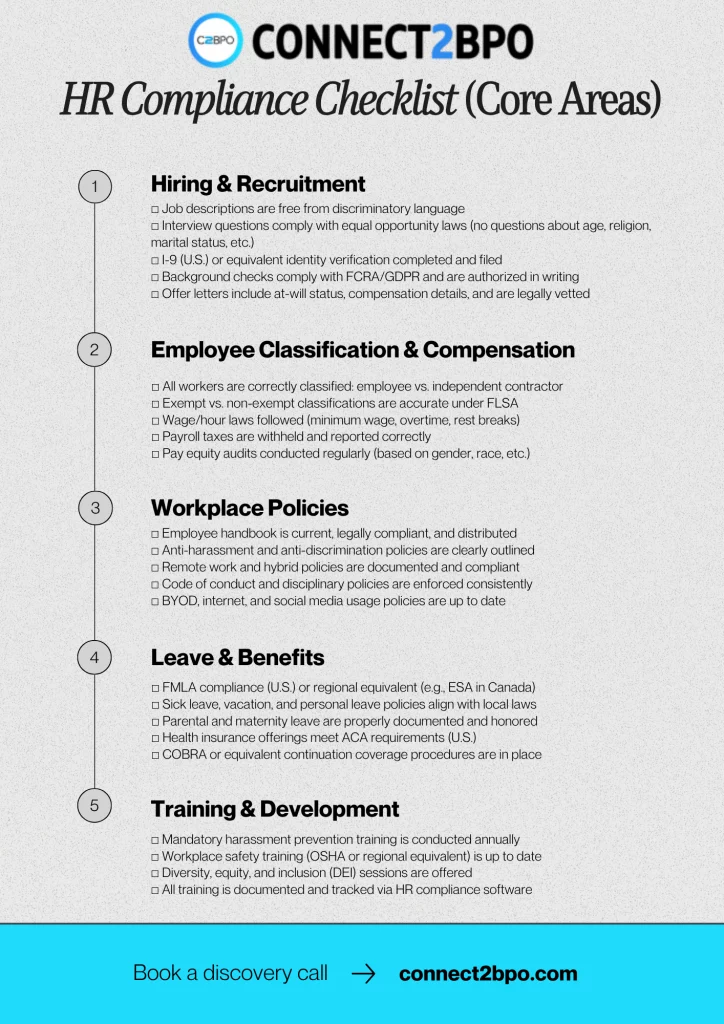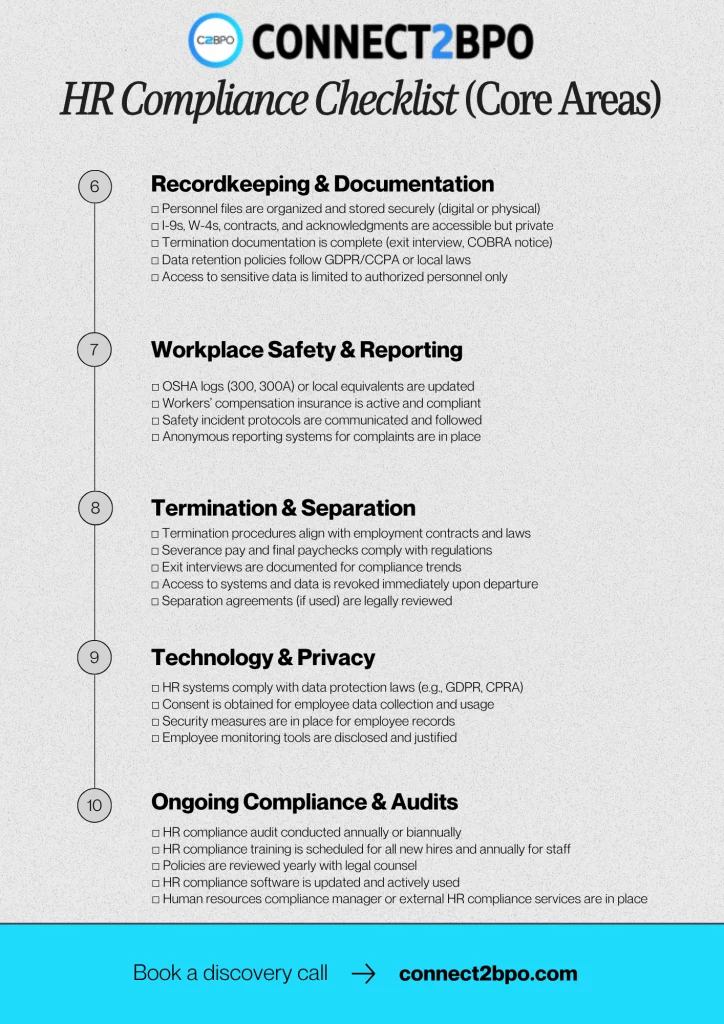HR compliance is no longer a quiet back-office function. In today’s legal and cultural climate, it’s a strategic pillar that protects organizations from costly litigation while nurturing a culture of integrity and inclusion. Whether you’re a startup or a global enterprise, understanding and executing effective human resources compliance practices isn’t optional; it’s mission-critical.
In this comprehensive guide, you’ll discover what HR compliance is, how to manage it proactively, and how tools like HR compliance software, expert HR compliance services, and a human resources compliance checklist can help you build a secure, scalable HR function.
Context
Compliance of HR was born out of necessity, driven by the increasing complexity of labor laws, employee rights, and the rising expectations of ethical corporate behavior. It wasn’t introduced as a trend or superficial metric; it emerged because companies began to face very real consequences—legal, financial, and reputational—for failing to protect their people and follow the law.
The origins of human resources compliance date back to the introduction of formal labor protections, such as the U.S. Fair Labor Standards Act in the 1930s, which regulated wages, working hours, and child labor. As governments created more regulations to protect workers, businesses needed an internal mechanism to ensure those laws were followed. That responsibility naturally fell under HR.
In the 1960s, with landmark laws like the Civil Rights Act (Title VII) and the rise of anti-discrimination protections, compliance became even more crucial. Human Resources departments were expected to create processes that would prevent and respond to discrimination, sexual harassment, and unequal treatment based on race, gender, religion, or disability. Over time, as legislation expanded to include data privacy (like GDPR), health and safety (OSHA), family leave (FMLA), and workplace accommodations, HR compliance grew into a full-fledged discipline with its own practices, training, and technology.
Public scandals and lawsuits in recent decades—ranging from wage theft cases to high-profile sexual harassment lawsuits—also fueled the evolution of HR compliance. Public pressure, social media visibility, and legal liabilities pushed organizations to go beyond basic policies. They had to prove—through audits, tracking systems, and reports—that they were protecting employee rights and acting responsibly. HR compliance became a shield against lawsuits, a tool to maintain reputation, and a critical way to foster employee trust.
In the digital age, remote work, cross-border hiring, and employee data collection created new layers of risk. Companies began relying on HR compliance software and services to automate training, monitor adherence, and stay up to date with rapidly changing laws. The role of the human resources compliance manager became vital, not only to interpret the law but also to integrate compliance into the culture of the organization.
Ultimately, the compliance of HR was born to ensure that companies didn’t just “say” they care about people. They had to prove it consistently and systematically. Today, it plays a strategic role in preventing lawsuits, protecting brand reputation, and building a culture where employees feel safe, respected, and fairly treated.
What Is HR Compliance and Why It’s Business-Critical
So, what is HR compliance? At its core, it’s the adherence to federal, state, and local employment laws governing labor practices, workplace safety, privacy, compensation, discrimination, and more. But true compliance of HR is more than meeting regulatory requirements. It’s about operationalizing ethical responsibility—ensuring every employee, from entry-level to C-suite, experiences a workplace that’s fair, secure, and respectful.
When HR departments misunderstand or overlook updates to the FMLA, ADA, or EEO guidelines, the consequences go beyond fines. Morale can plummet, retention rates may drop, and trust in leadership erodes. That’s why HR compliance must be seen not as a one-time legal review, but as a living function integrated into everyday operations.
Human Resources Compliance as Strategic Risk Management
The importance of human resources compliance has escalated. With workplace regulations increasing, remote work policies changing the landscape, and social justice movements demanding transparency, the risks of non-compliance are higher than ever. Employee expectations are also shifting—they demand equity, transparency, and psychological safety. Combine that with fragile corporate reputations, and it’s clear: compliance must be preemptive, not reactive.
Organizations leading the way are investing in HR compliance training, deploying HR compliance software for traceability, and assigning dedicated human resources compliance managers to monitor and execute policy. These steps are critical to avoid litigation, maintain credibility, and foster a healthy work environment.
Key Employment Laws Every HR Department Should Understand
While HR compliance spans a broad legal framework, some laws are foundational:
- Fair Labor Standards Act (FLSA): Governs wage rules, overtime, and worker classifications.
- Family and Medical Leave Act (FMLA): Grants job-protected, unpaid leave for family or health reasons.
- Equal Employment Opportunity (EEO) laws: Prevent discrimination and promote equal hiring practices.
- Americans with Disabilities Act (ADA): Ensures reasonable workplace accommodations.
- Occupational Safety and Health Act (OSHA): Enforces standards to maintain safe working environments.
- HIPAA and GDPR: Regulate health and data privacy.
Each law brings specific responsibilities. HR professionals must not only understand these regulations but also translate them into policies that are communicated clearly and enforced consistently.
HR Compliance Training: Prevention Through Education
One of the most effective tools in achieving HR compliance is training. Regular HR compliance training empowers employees to recognize misconduct, follow procedures, and protect both themselves and the company. This training should not be generic. It must be tailored to roles, reflect real-world scenarios, and be updated frequently to reflect new laws and internal policies.
A compliance program that prioritizes education builds a culture where prevention is valued over correction. It shows employees that the organization takes compliance seriously, which increases trust and decreases legal risk.
How to Achieve Compliance in HR
To move from theory to practice, HR leaders must embed compliance in daily workflows. Begin with a full audit of your current policies and compare them to recent legal updates. Then establish clear documentation, reinforce expectations through training, and assign accountability.
Use HR compliance software to track policy acknowledgments, log training completions, and maintain employee records. Assign a human resources compliance manager to oversee updates, respond to complaints, and interface with legal counsel when needed. These steps lay the groundwork for a proactive and sustainable compliance model.
📌 Real-World Case Study: How Legal Fallout Drove HR Compliance Overhaul
One powerful example of non-compliance and its consequences comes from Sunshine Raisin Corp., a California-based raisin and dried fruit company. In March 2024, the U.S. Equal Employment Opportunity Commission (EEOC) announced that Sunshine had agreed to pay $2 million to settle allegations of widespread sexual harassment against female farm workers. The charges—spanning over a decade—accused supervisors and coworkers of routine sexual misconduct, including groping and offensive comments. The company also allegedly retaliated by firing women for speaking up reuters.com.
Why did this spiral into a multimillion-dollar lawsuit? The EEOC revealed that complaints had been dismissed consistently, and reporting mechanisms were broken. In many cases, farm workers spoke little English, allowing harassment to continue unchecked. Even worse, workers were penalized for reporting the abuse .
In addition to the financial costs, the EEOC settlement mandated an overhaul of the company’s internal policies, including:
- A full revision of their anti-harassment framework,
- Mandatory training for all staff,
- Implementation of an independent monitoring system to track future complaints europe-hr-solutions.com+11reuters.com+11reuters.com+11.
The blowback provides a stark lesson: Weak or invisible HR compliance mechanisms not only fail the workforce—they devastate company finances and reputation.
🔧 From Crisis to Compliance Strategy
Here’s how Sunshine Raisin turned disaster into an opportunity:
- Recognizing the failure: Post-settlement, executives realized their policies and hotline systems were ineffective, especially for non-English speakers.
- Policy translation & accessibility upgrades: New protocols were translated and simplified, delivered via bilingual training—making reporting truly accessible.
- Automated training tracking: The company invested in HR compliance software to schedule e-learning and track completion rates.
- Monitoring and external oversight: A third-party monitor was brought in to audit compliance quarterly, and a human resources compliance manager was appointed to spearhead internal reforms.
Within 12 months, Sunshine Raisin reported zero new EEOC claims and a 70% increase in reported incidents—signifying improved trust and visibility. Not only did they avoid further legal exposure, but they also rebuilt credibility with regulators, workers, and partners.
Why This Matters
- Cost of non-compliance: A $2-million legal settlement isn’t just a number—it’s lost public trust, canceled contracts, and internal disruption.
- Simple oversight creates vulnerability: Without accessible reporting mechanisms and HR accountability, abuse can remain hidden for years.
- Your takeaway: Don’t wait for crisis. Empower your organization with:
- Bilingual training and easy-to-access policy updates,
- An empowered human resources compliance manager,
- Real-time compliance tracking through HR compliance software or services.
- Bilingual training and easy-to-access policy updates,
Leveraging HR Compliance Software and Services
In an era of remote work and digital documentation, spreadsheets are no longer sufficient. Modern HR compliance software enables organizations to automate alerts, standardize documentation, and ensure audit readiness.
HR compliance services can also be an asset—particularly for small to mid-sized businesses that lack in-house expertise. These services provide guidance, templates, legal interpretations, and staff training modules that save time and reduce exposure.

✅ HR Compliance Checklist (Core Areas)
Every compliance strategy should include a regularly updated human resources compliance checklist. Here are essential items to include:
- Job descriptions that align with FLSA classifications
- Documentation of completed HR compliance training
- ADA-compliant accommodations and facilities
- Harassment prevention policies with clear reporting procedures
- Data privacy policies and employee consent forms
- Assigned human resources compliance manager roles
This checklist should be revisited quarterly to adapt to legal updates and business changes.
1. Hiring & Recruitment
- ☐ Job descriptions are free from discriminatory language
- ☐ Interview questions comply with equal opportunity laws (no questions about age, religion, marital status, etc.)
- ☐ I-9 (U.S.) or equivalent identity verification completed and filed
- ☐ Background checks comply with FCRA/GDPR and are authorized in writing
- ☐ Offer letters include at-will status, compensation details, and are legally vetted
2. Employee Classification & Compensation
- ☐ All workers are correctly classified: employee vs. independent contractor
- ☐ Exempt vs. non-exempt classifications are accurate under FLSA
- ☐ Wage/hour laws followed (minimum wage, overtime, rest breaks)
- ☐ Payroll taxes are withheld and reported correctly
- ☐ Pay equity audits conducted regularly (based on gender, race, etc.)
3. Workplace Policies
- ☐ Employee handbook is current, legally compliant, and distributed
- ☐ Anti-harassment and anti-discrimination policies are clearly outlined
- ☐ Remote work and hybrid policies are documented and compliant
- ☐ Code of conduct and disciplinary policies are enforced consistently
- ☐ BYOD, internet, and social media usage policies are up to date
4. Leave & Benefits
- ☐ FMLA compliance (U.S.) or regional equivalent (e.g., ESA in Canada)
- ☐ Sick leave, vacation, and personal leave policies align with local laws
- ☐ Parental and maternity leave are properly documented and honored
- ☐ Health insurance offerings meet ACA requirements (U.S.)
- ☐ COBRA or equivalent continuation coverage procedures are in place
5. Training & Development
- ☐ Mandatory harassment prevention training is conducted annually
- ☐ Workplace safety training (OSHA or regional equivalent) is up to date
- ☐ Diversity, equity, and inclusion (DEI) sessions are offered
- ☐ All training is documented and tracked via HR compliance software
6. Recordkeeping & Documentation
- ☐ Personnel files are organized and stored securely (digital or physical)
- ☐ I-9s, W-4s, contracts, and acknowledgments are accessible but private
- ☐ Termination documentation is complete (exit interview, COBRA notice)
- ☐ Data retention policies follow GDPR/CCPA or local laws
- ☐ Access to sensitive data is limited to authorized personnel only
7. Workplace Safety & Reporting
- ☐ OSHA logs (300, 300A) or local equivalents are updated
- ☐ Workers’ compensation insurance is active and compliant
- ☐ Safety incident protocols are communicated and followed
- ☐ Anonymous reporting systems for complaints are in place
8. Termination & Separation
- ☐ Termination procedures align with employment contracts and laws
- ☐ Severance pay and final paychecks comply with regulations
- ☐ Exit interviews are documented for compliance trends
- ☐ Access to systems and data is revoked immediately upon departure
- ☐ Separation agreements (if used) are legally reviewed
9. Technology & Privacy
- ☐ HR systems comply with data protection laws (e.g., GDPR, CPRA)
- ☐ Consent is obtained for employee data collection and usage
- ☐ Security measures are in place for employee records
- ☐ Employee monitoring tools are disclosed and justified
10. Ongoing Compliance & Audits
- ☐ HR compliance audit conducted annually or biannually
- ☐ HR compliance training is scheduled for all new hires and annually for staff
- ☐ Policies are reviewed yearly with legal counsel
- ☐ HR compliance software is updated and actively used
- ☐ Human resources compliance manager or external HR compliance services are in place

The Strategic Role of a Human Resources Compliance Manager
Designating a human resources compliance manager ensures ongoing oversight. This role isn’t just administrative—it’s strategic. A good compliance manager stays informed of legislative changes, leads investigations, ensures documentation integrity, and reports directly to legal or executive leadership. In many organizations, this role acts as the ethical conscience of HR, ensuring that the workplace operates lawfully and ethically.
Looking Ahead: Trends Shaping HR Compliance
Compliance of HR is becoming more complex. New trends include AI regulation in recruitment tools, legal protections for mental health, and pay transparency laws that affect how roles are advertised. HR professionals must stay vigilant and agile to navigate these changes.
As the business environment evolves, so too must your compliance strategy. From tech adoption to cultural awareness, the human resources compliance field will demand both legal literacy and emotional intelligence.
Conclusion: A Culture of Accountability
Ultimately, the compliance of HR isn’t about checking boxes. It’s about embedding integrity into the DNA of your organization. Companies that prioritize HR compliance training, invest in smart HR compliance software, and empower human resources compliance managers build more than safe workplaces—they build trustworthy brands.
So if you’re still treating compliance as a burden, it’s time to flip the script. Make it a competitive advantage. Your people—and your reputation—depend on it.



